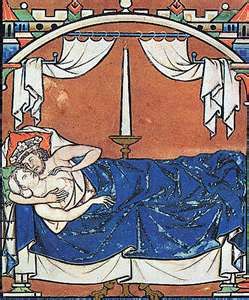XIV: Fourteenth International Congress of Medieval Canon Law
August 5 – 11, 2012 (Toronto, Canada)
Adultery in Late-Medieval Northern France
Sara McDougall (CUNY)
Medieval canonists unequivocally condemned extramarital sex. What did people do with these laws? This paper examined gender and how these laws handled wife vs. husband.McDougall began by discussing two canonical rules and then relating them to cases found in northern France. The first canonical rule: enclosure in a monastery as punishment for adulteresses. This played no discernible role in France before the 16th century. The second rule: husbands cannot kill their cheating wives even if they caught them in the act.
A common punishment for adulterous women – whipping, head shaving, and parading the adulteress through the streets resembles the entry procedure before enclosure. The husband could take her back or leave her perpetually enclosed. Canonists also agreed that adultery was inclusive of men, and even went as far to opine that a husband’s cheating was worse. However, in practice, most canonists focused mainly on women, and not on cheating husbands. In Southern France, men and women were whipped for adultery.
In the 15th century, parliament was not punishing adulterous wives by enclosure but they did call for punishment for those who murdered their husbands by enclosure. If a woman had not compounded her crime of adultery with murder, prior to the 16th century, she was not enclosed. Not examples have yet been found contrary to this.
Adultery was a lesser evil than the murder of a spouse therefore adulterous wives could not be killed. If a man murdered his wife, the husband was banished or lost his wife’s property and the ability to remarry or would require dispensation to remarry. Canonists were more concerned with husbands killing wives, than wives killing husbands and this made sense due to prior cultural norms and law. Prior to the Christian era, husbands had the right to kill adulterous wives. This is why canonists were more concerned with this behaviour. Murderous husbands who sought royal remission had to offer “carefully crafted narratives” where they had clearly tried to correct a unrepentant wife. In many cases, even with these narratives, they were still executed by royal officials. The dispensation to marry was extremely rare, and only one example could be found from Italy. Canonical prohibition on marital homicide had an impact on behaviour and caused husbands to go after the lover instead.
XIV: Fourteenth International Congress of Medieval Canon Law
August 5 – 11, 2012 (Toronto, Canada)
Adultery in Late-Medieval Northern France
Sara McDougall (CUNY)
Medieval canonists unequivocally condemned extramarital sex. What did people do with these laws? This paper examined gender and how these laws handled wife vs. husband.McDougall began by discussing two canonical rules and then relating them to cases found in northern France. The first canonical rule: enclosure in a monastery as punishment for adulteresses. This played no discernible role in France before the 16th century. The second rule: husbands cannot kill their cheating wives even if they caught them in the act.
A common punishment for adulterous women – whipping, head shaving, and parading the adulteress through the streets resembles the entry procedure before enclosure. The husband could take her back or leave her perpetually enclosed. Canonists also agreed that adultery was inclusive of men, and even went as far to opine that a husband’s cheating was worse. However, in practice, most canonists focused mainly on women, and not on cheating husbands. In Southern France, men and women were whipped for adultery.
In the 15th century, parliament was not punishing adulterous wives by enclosure but they did call for punishment for those who murdered their husbands by enclosure. If a woman had not compounded her crime of adultery with murder, prior to the 16th century, she was not enclosed. Not examples have yet been found contrary to this.
Adultery was a lesser evil than the murder of a spouse therefore adulterous wives could not be killed. If a man murdered his wife, the husband was banished or lost his wife’s property and the ability to remarry or would require dispensation to remarry. Canonists were more concerned with husbands killing wives, than wives killing husbands and this made sense due to prior cultural norms and law. Prior to the Christian era, husbands had the right to kill adulterous wives. This is why canonists were more concerned with this behaviour. Murderous husbands who sought royal remission had to offer “carefully crafted narratives” where they had clearly tried to correct a unrepentant wife. In many cases, even with these narratives, they were still executed by royal officials. The dispensation to marry was extremely rare, and only one example could be found from Italy. Canonical prohibition on marital homicide had an impact on behaviour and caused husbands to go after the lover instead.
Subscribe to Medievalverse
Related Posts